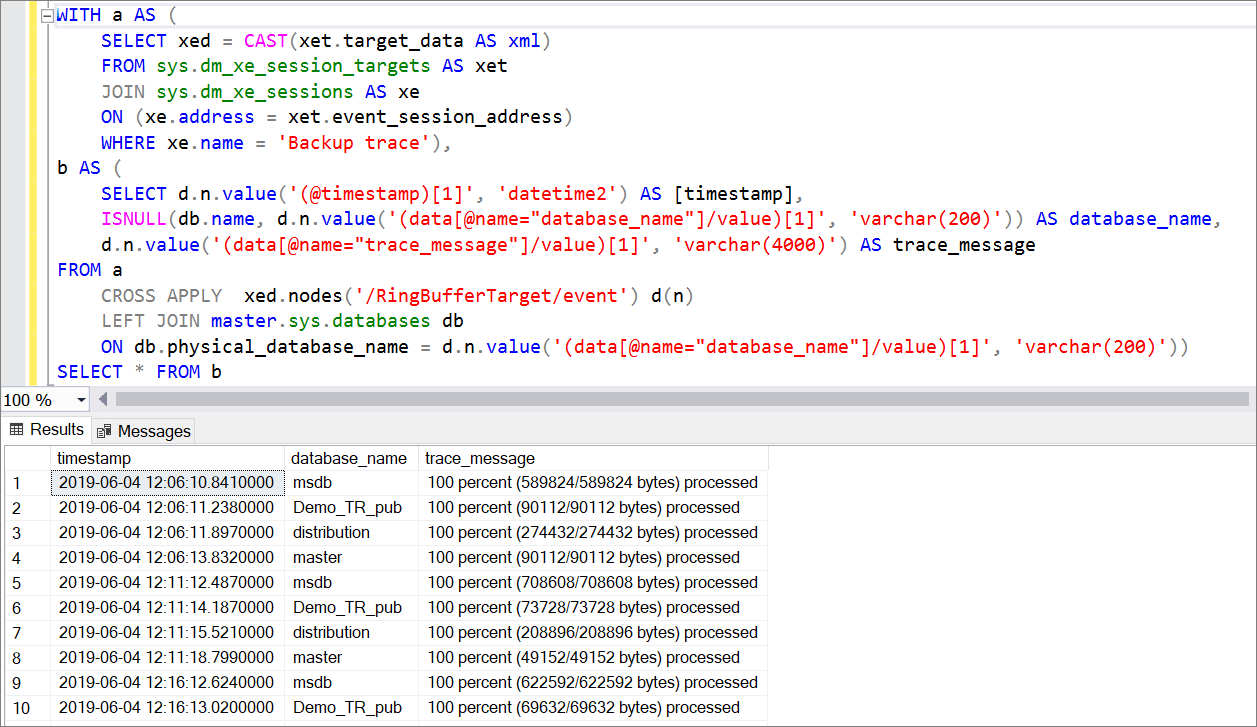Monitor backup activity for Azure SQL Managed Instance
Applies to:
Azure SQL Managed Instance
This article teaches you how to monitor backup activity for Azure SQL Managed Instance by either querying the msdb database or by configuring extended event (XEvent) sessions.
Overview
Azure SQL Managed Instance stores backup information in the msdb database and also emits events (also known as Extended Events or XEvents) during backup activity for the purpose of reporting. Configure an XEvent session to track information such as backup status, backup type, size, time, and location within the msdb database. This information can be integrated with backup monitoring software and also used for the purpose of Enterprise Audit.
Enterprise Audits may require proof of successful backups, time of backup, and duration of the backup.
Query msdb database
To view backup activity, run the following query from user-defined database:
SELECT TOP (30) bs.machine_name, bs.server_name, DB_NAME(DB_ID(bs.database_name)) AS [Database Name], bs.recovery_model,
CONVERT (BIGINT, bs.backup_size / 1048576 ) AS [Uncompressed Backup Size (MB)],
CONVERT (BIGINT, bs.compressed_backup_size / 1048576 ) AS [Compressed Backup Size (MB)],
CONVERT (NUMERIC (20,2), (CONVERT (FLOAT, bs.backup_size) /
CONVERT (FLOAT, bs.compressed_backup_size))) AS [Compression Ratio], bs.has_backup_checksums, bs.is_copy_only, bs.encryptor_type,
DATEDIFF (SECOND, bs.backup_start_date, bs.backup_finish_date) AS [Backup Elapsed Time (sec)],
bs.backup_finish_date AS [Backup Finish Date], bmf.physical_device_name AS [Backup Location], bmf.physical_block_size
FROM msdb.dbo.backupset AS bs WITH (NOLOCK)
INNER JOIN msdb.dbo.backupmediafamily AS bmf WITH (NOLOCK)
ON bs.media_set_id = bmf.media_set_id
WHERE DB_ID(bs.database_name) = DB_ID()
AND bs.[type] = 'D'
ORDER BY bs.backup_finish_date DESC OPTION (RECOMPILE);
Configure XEvent session
Use the extended event backup_restore_progress_trace to record the progress of your SQL Managed Instance back up. Modify the XEvent sessions as needed to track the information you're interested in for your business. These T-SQL snippets store the XEvent sessions in the ring buffer, but it's also possible to write to Azure Blob Storage. XEvent sessions storing data in the ring buffer have a limit of about 1000 messages so should only be used to track recent activity. Additionally, ring buffer data is lost upon failover. As such, for a historical record of backups, write to an event file instead.
Simple tracking
Configure a simple XEvent session to capture simple events about complete full backups. This script collects the name of the database, the total number of bytes processed, and the time the backup completed.
Use Transact-SQL (T-SQL) to configure the simple XEvent session:
CREATE EVENT SESSION [Simple backup trace] ON SERVER
ADD EVENT sqlserver.backup_restore_progress_trace(
WHERE operation_type = 0
AND trace_message LIKE '%100 percent%')
ADD TARGET package0.ring_buffer
WITH(STARTUP_STATE=ON)
GO
ALTER EVENT SESSION [Simple backup trace] ON SERVER
STATE = start;
Verbose tracking
Configure a verbose XEvent session to track greater details about your backup activity. This script captures start and finish of both full, differential and log backups. Since this script is more verbose, it fills up the ring buffer faster, so entries may recycle faster than with the simple script.
Use Transact-SQL (T-SQL) to configure the verbose XEvent session:
CREATE EVENT SESSION [Verbose backup trace] ON SERVER
ADD EVENT sqlserver.backup_restore_progress_trace(
WHERE (
[operation_type]=(0) AND (
[trace_message] like '%100 percent%' OR
[trace_message] like '%BACKUP DATABASE%' OR [trace_message] like '%BACKUP LOG%'))
)
ADD TARGET package0.ring_buffer
WITH (MAX_MEMORY=4096 KB,EVENT_RETENTION_MODE=ALLOW_SINGLE_EVENT_LOSS,
MAX_DISPATCH_LATENCY=30 SECONDS,MAX_EVENT_SIZE=0 KB,MEMORY_PARTITION_MODE=NONE,
TRACK_CAUSALITY=OFF,STARTUP_STATE=ON)
ALTER EVENT SESSION [Verbose backup trace] ON SERVER
STATE = start;
Monitor backup progress
After the XEvent session is created, you can use Transact-SQL (T-SQL) to query ring buffer results and monitor the progress of the backup. Once the XEvent starts, it collects all backup events so entries are added to the session roughly every 5-10 minutes.
Simple tracking
The following Transact-SQL (T-SQL) code queries the simple XEvent session and returns the name of the database, the total number of bytes processed, and the time the backup completed:
WITH
a AS (SELECT xed = CAST(xet.target_data AS xml)
FROM sys.dm_xe_session_targets AS xet
JOIN sys.dm_xe_sessions AS xe
ON (xe.address = xet.event_session_address)
WHERE xe.name = 'Backup trace'),
b AS(SELECT
d.n.value('(@timestamp)[1]', 'datetime2') AS [timestamp],
ISNULL(db.name, d.n.value('(data[@name="database_name"]/value)[1]', 'varchar(200)')) AS database_name,
d.n.value('(data[@name="trace_message"]/value)[1]', 'varchar(4000)') AS trace_message
FROM a
CROSS APPLY xed.nodes('/RingBufferTarget/event') d(n)
LEFT JOIN master.sys.databases db
ON db.physical_database_name = d.n.value('(data[@name="database_name"]/value)[1]', 'varchar(200)'))
SELECT * FROM b
The following screenshot shows an example of the output of the above query:

In this example, five databases were automatically backed up over the course of 2 hours and 30 minutes, and there are 130 entries in the XEvent session.
Verbose tracking
The following Transact-SQL (T-SQL) code queries the verbose XEvent session and returns the name of the database, as well as the start and finish of both full, differential and log backups.
WITH
a AS (SELECT xed = CAST(xet.target_data AS xml)
FROM sys.dm_xe_session_targets AS xet
JOIN sys.dm_xe_sessions AS xe
ON (xe.address = xet.event_session_address)
WHERE xe.name = 'Verbose backup trace'),
b AS(SELECT
d.n.value('(@timestamp)[1]', 'datetime2') AS [timestamp],
ISNULL(db.name, d.n.value('(data[@name="database_name"]/value)[1]', 'varchar(200)')) AS database_name,
d.n.value('(data[@name="trace_message"]/value)[1]', 'varchar(4000)') AS trace_message
FROM a
CROSS APPLY xed.nodes('/RingBufferTarget/event') d(n)
LEFT JOIN master.sys.databases db
ON db.physical_database_name = d.n.value('(data[@name="database_name"]/value)[1]', 'varchar(200)'))
SELECT * FROM b
The following screenshot shows an example of a full backup in the XEvent session:

The following screenshot shows an example of an output of a differential backup in the XEvent session:

Next steps
Once your backup has completed, you can then restore to a point in time or configure a long-term retention policy.
To learn more, see automated backups.